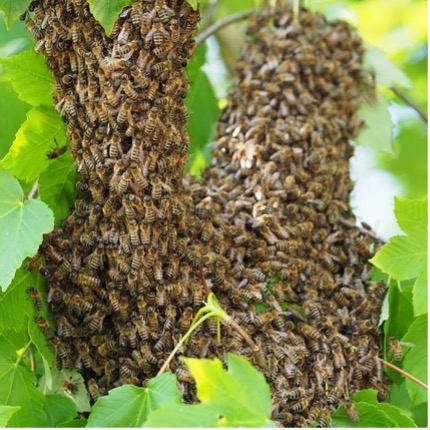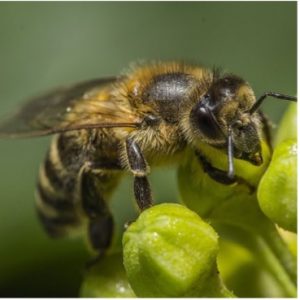
A swarm of bees is a spectacular event, but it can be an alarming sight and sound to a non-beekeeper! There may be many thousands of bees swirling around and buzzing loudly before they settle down into a cluster.
- It is important to understand that swarming is a natural, reproductive and dispersal process that is non-threatening to humans.
- Swarms most often occur between May and July, when a new queen has been raised and the old queen leaves the hive to start a new colony elsewhere.
- Swarming bees will often hang in a cluster, usually from a tree branch, while scout bees look for a new site for the colony.
- A clustered swarm is generally calm, since the bees are full of food from the old hive. You should, however, keep a safe distance from it and ensure that children and pets do not disturb it.
- Once the scout bees have identified a new site the cluster will take off again and disappear. This may take anything from a few minutes to a few days!


There are many kinds of bee-like insects. So before calling a beekeeper it is important that you make sure they are honey bees and not something else! There is an excellent guide on the British Bee Keepers Association [BBKA] website.
Most sightings that are believed to be swarms, are not honey bees at all – they are bumble bees. Most commonly these are tree bumble bees, but they may be any solitary or social bumble bee or related species. They may nest in a range of places including holes in air bricks, bird boxes or even in the ground. You will see these bees coming and going in much smaller numbers than a honey bee swarm.
Honey Bees…
If your bees look like this, and are outside, then you may need a beekeeper to deal with them! Provided the swarm can be reached safety, RBKA members will be able to assist you with picking them up and removing them. To find your nearest swarm collector please use the following link:
https://www.bbka.org.uk/find-a-local-swarm-collector
For RBKA to help you, the volunteer will need some information. Please provide as many of the following details as possible:
- Location of the swarm your name, address and postcode. Please include a telephone number.
- Approximately how long has the swarm been in the same place – as far as you know.
- How big is the swarm? Use diameter, length x width or compare to a common object such as tennis ball, football or dustbin.
- What is the height and position of the cluster?
- If on the outside of a building is the cluster near a door or window?
- Will a ladder be necessary and available?
- If possible attach a photograph, but only do so from a safe distance and do not disturb the bees!
- If you are unable to find a swarm collector nearby, then email swarms@ryedalebees.co.uk with the above information.
If the swarm or colony is in a building…
Unfortunately we are unable to collect a swarm of bees, or colony, if they are inside a building, on a roof or in a chimney.
If this describes your situation , please read the information on this link. What to do with bees in buildings.
Before contacting Pest Control, please read the following bulletin from Beewise and think about the bees.



